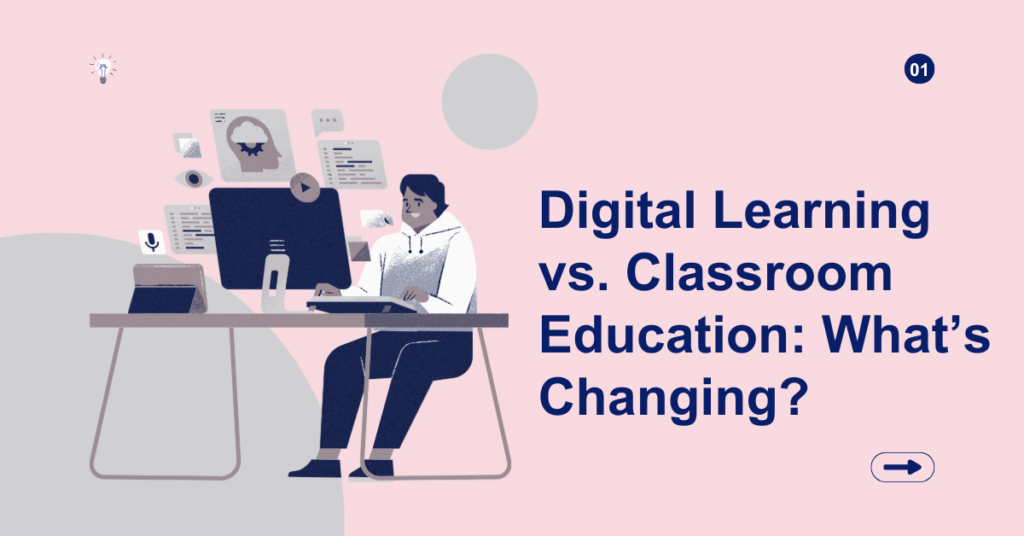Digital Learning vs. Classroom Education: What’s Changing?
Technology has changed a lot of things in our lives, and now it is also changing how we study. Earlier, students used to sit in classrooms with teachers and learn face-to-face. But now, because of the internet, mobile phones, and computers, many students are learning online. This is called digital learning. The COVID-19 pandemic made this shift even faster because schools were closed, and everyone had to study from home.
Digital learning has many good things like students can study from anywhere, anytime, and it can even save money. But there are also some problems like students don’t meet their friends much, and they spend too much time on screens. Some students also don’t have good internet or devices at home, which makes it difficult for them. Even though online learning has its problems, mixing classroom learning with digital learning, called hybrid learning, might be the best idea. With new technology coming and the government supporting digital education, online learning is going to become even bigger in the future.
Moving from Classroom Learning to Online Learning
In classroom learning, students sit in a physical class with teachers, learning together with friends. It is more face-to-face, and students can ask questions directly to the teacher. But digital learning is different. It uses online classes, e-books, mobile apps, and videos to teach students from home.
Some reasons why more people are choosing digital learning:
- More people have smartphones and internet now.
- Learning platforms like BYJU’S, Coursera, and Udemy are becoming popular.
- Students like to study at their own speed and in their own style.
- Students want to learn skills that are not always taught in schools.

Why Digital Learning is Better in Some Ways
- Easy to Access for Everyone
The best thing about digital learning is that anyone can study from anywhere.
- Students can watch videos and read notes anytime they want.
- Students in villages can also get good education without going to big cities.
- There are special tools for students with disabilities, like text-to-speech and language translators.
- Flexible and Learn at Your Own Speed
In classrooms, students have to follow a timetable, but in digital learning, they can study whenever they want.
- Students can repeat tough topics again and again until they understand.
- People who are working can also study after their job hours.
- Students can choose subjects they like and learn things that match their career goals.
- Cheaper than Regular Schools
Online learning can save money in many ways.
- No need to travel to schools, so no travel costs.
- Schools and colleges don’t have to spend much on buildings and classrooms.
- Many online courses are free or very cheap, making it affordable for everyone.
- Fun and Interactive Learning
Digital learning uses new technology like AI (Artificial Intelligence), VR (Virtual Reality), and AR (Augmented Reality) to make studying interesting.
- Learning games make hard subjects more fun and easier to understand.
- AI tutors help students by giving quick feedback and study plans.
- VR tools help students see and understand things like science experiments or medical procedures better.
Problems Faced in Digital Learning
- Less Face-to-Face Interaction
In classroom learning, students can meet teachers and friends, which makes learning more lively. But in digital learning:
- Students may feel bored because there is no classroom environment.
- It’s harder to clear doubts when you can’t ask teachers directly.
- Students don’t get to work in groups, which affects teamwork skills.
- Not Everyone Has Internet or Devices
Many students, especially from villages or poor families, don’t have laptops or fast internet.
- Students in rural areas struggle to attend online classes due to poor internet.
- Some students and teachers don’t know how to use online learning apps properly.
- Health Problems from Too Much Screen Time
Sitting in front of a computer for long hours is not good for health.
- Students can get eye pain or headaches from staring at screens.
- Not moving much can lead to obesity and bad posture.
- Some students feel lonely because they don’t get to meet their friends in person.
- Not All Online Courses Are Good
There are too many courses online, but not all of them are useful.
- Some courses have wrong or low-quality information.
- Many online courses don’t have proper certificates that are accepted by employers.
- It’s easy to cheat in online exams, which makes it hard to trust online assessments.
Hybrid Learning: Mixing Online and Classroom Education
To solve the problems of both online and classroom learning, many schools are now using hybrid learning. This means students learn partly in the classroom and partly online. Students attend some classes in person, while other lessons are online. Teachers use online tools even in classrooms to make learning better. Subjects like medicine or engineering, which need practical work, use online simulations but still have hands-on labs.
What the Government is Doing to Support Digital Learning
The Indian government is doing many things to make digital learning better and accessible to everyone.
- DIKSHA (Digital Infrastructure for Knowledge Sharing): This is an online platform for school students to get learning materials.
- SWAYAM (Study Webs of Active Learning for Young Aspiring Minds): Offers free online courses from top colleges like IITs and IIMs.
- PM eVidya: This program helps students learn through online classes, TV channels, and even radio.
- National Digital Library: Students can read books and research materials online for free.
Conclusion
Digital learning has changed the way we study. It offers many benefits like flexibility, lower costs, and new fun ways to learn. But it also has its problems like health issues, less social interaction, and unequal access to technology. The best solution might be hybrid learning, which mixes classroom and online education. With the government helping and technology getting better, digital learning will continue to grow and shape the future of education in India and around the world.
